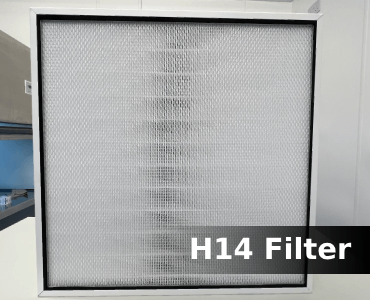Reaching higher cleanliness standards is always a challenge for places such as cleanrooms and laboratories, where absolute air cleanliness is prime. One of the major parts contributing to the cleanliness of places is the HEPA filter. The HEPA filter has been specifically designed for trapping tiny particles so that the air one inhales conforms to really stringent standards. The blog explains how HEPA filters are of significance in cleanrooms and laboratories, different categories, and how such filters make the environment safer and well-controlled.

What Are HEPA Filters?
HEPA filters are known for High-Efficiency Particulate Air filters, and besides
other things, it is one of the most popular air-cleaning categories by having a
capture efficiency of 99.97% of particles 0.3 microns or bigger. Dust, pollen,
mold, and bacteria can be among these impurities affecting the purity of
cleanroom environments or laboratory processes.
These different standards for HEPA filters evaluate the efficiency and
performance of filters, with H14 HEPA Filter being one
of the most widely used in high-purity applications. H14 filters are classified
under the EN1822 standard, providing at least 99.99% filtration efficiency, thus
appropriate even for the most sensitive environments.
Importance of HEPA Filters in Cleanrooms
A cleanroom refers to a controlled environment wherein conditions such as temperature, humidity, and air quality are regulated within specified levels to control contamination. Such environments find their applications extensively in the fields of pharmaceuticals, biotechnology, electronics, and healthcare. In these environments, HEPA filters are the key to remove airborne biological and particulate contamination from the ambient air:
- Filtration Efficiency: Based on the sensitivity of the process involved, using an H14 HEPA filter or better would provide the best options for particle removal.
- Airflow Capability: The filter's airflow rating should be able to satisfy the loads imposed on the HVAC system to reduce the wastage of the product without affecting the performance at work.
- Filters Construction: Different types of HEPA filters available involve pleated panels, box-type, and compact filter units. The proper construction type ensures that it fits better and lasts longer against extreme conditions or demanding environments.
- HEPA Filter Factory Suppliers: Select dependable, high-quality HEPA filter factory suppliers providing equipment that meets acceptable industry standards. Preferably, looking for companies with appropriate certifications-ISO 9001-and adhering to guidelines particular to their industries is the best.
Maintenance and Replacement of HEPA Filters
To keep the HEPA filters efficient, overseeing maintenance and inspections in regular intervals is always required. Key practices include:
- Regular Inspection: Regular observation should be done for dust buildup, blockages in the overall structure, or mechanical damages.
- Proper Sealing: The filter should be sealed properly to avoid air bypass leakage.
- Scheduled Replacement: Replace the HEPA filters at a scheduled time depending on usage and ambient conditions so that it affords maximum performance.
Conclusion
HEPA filters play a crucial role in air cleanliness for cleanrooms and laboratories in order to provide safety to workers, experiment integrity, and regulation compliance. By choosing top-notch H14 HEPA filters from reputed manufacturers, clean air and contamination control can presumably be achieved. Their role in achieving this can be greatly enhanced through knowledge and good maintenance throughout the longevity of the cleanroom or laboratory.

